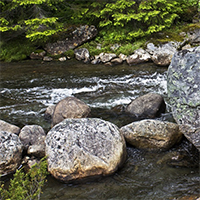Impacts of an extreme flood on the ecosystem of a headwater stream

All claims expressed in this article are solely those of the authors and do not necessarily represent those of their affiliated organizations, or those of the publisher, the editors and the reviewers. Any product that may be evaluated in this article or claim that may be made by its manufacturer is not guaranteed or endorsed by the publisher.
Authors
Headwater streams are the smallest parts of rivers but make up the majority of river miles. The chemistry and macroinvertebrate composition of such streams are among the most important indicators of their environmental health. Macroinvertebrates are affected namely by runoff genesis and, in many regions of the world, also by acid atmospheric deposition and its consequences. The aim of this paper is to evaluate the impacts of an extreme summer flash flood on the physical environment, chemistry and macroinvertebrates in a small headwater stream located in the Beech-woods National Nature Reserve of the Jizera Mts. (Northern Bohemia, Czech Republic). The studied stream is characterized by a pluvial hydrologic regime with perennial streamflow uniformly distributed within the year, with peak-flows originating mainly from summer rainstorms, and moderate current anthropogenic acidification. During the observed summer flash flood of the return period near 1,000 years, high currents (1-2.5 m s-1) flushed out 2.7 m3 of sand and gravel from the streambed, resulting in a devastating effect on macroinvertebrates. Both number of species/taxa and diversity were reduced by about 50% while the abundance of surviving taxa was reduced to about 10% compared with before the flood. The following spring after the event, both number of species/taxa, diversity and abundance increased, partially due to the temporary unsuccessful colonization of the site by several alien species creating a peak of biological diversity, but complete recovery of the original macroinvertebrate assemblages was not observed even during the subsequent two years. On the other hand, a significant drop in sulphate contents and rising alkalinity observed in stream waters during base flow conditions after the flood indicate positive effects on recovery of the aquatic environment by depleting the catchment sulphur pool. Thus, the flood did not significantly alter the long-term recovery of the studied headwater stream from acidification.
Edited by
Francesca Bona, Dept. of Life Sciences and Systems Biology, University of Turin, ItalyHow to Cite

This work is licensed under a Creative Commons Attribution-NonCommercial 4.0 International License.






